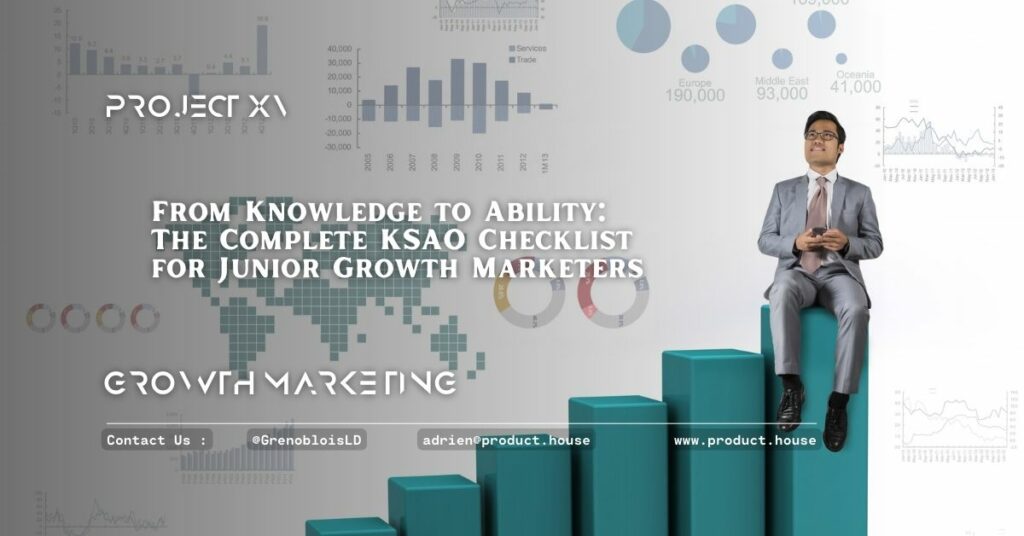Mastering the Art of UX Design: The Top 60 KSAOs Every Junior UX Designer Needs to Succeed

KSAOs List
Definitions and Disclaimer
KSAO is an acronym that stands for Knowledge, Skills, Abilities, and Other characteristics. It is a framework used in the field of human resources to identify the competencies required for a job position. The KSAO framework provides a structured way to evaluate and assess job candidates and employees based on their knowledge, skills, abilities, and other characteristics that are essential for performing a particular job.
The KSAO framework is widely used in job analysis and design, recruitment, selection, training, and performance management. By analyzing a job in terms of the required KSAOs, organizations can create job descriptions, design training programs, and identify the most suitable candidates for a particular role.
For students pursuing a career in UX design, understanding the KSAOs required for the job is crucial. Knowledge refers to the theoretical and conceptual understanding of UX design principles, tools, and techniques. Skills are the practical abilities needed to perform specific tasks, such as wireframing, prototyping, and usability testing. Abilities are the inherent traits that enable a person to perform the job, such as creativity, attention to detail, and problem-solving. Other characteristics might include communication skills, teamwork, and adaptability.
By detailing every KSAO required for UX design, students can better understand the expectations of the job and what they need to work on to excel in the field. For example, a student might focus on building their knowledge of design thinking, learning how to use popular design tools like Sketch or Figma, and improving their ability to collaborate with others on projects. Understanding the KSAOs required for a job also helps students to identify areas where they may need to improve their skills or seek additional training and education.
In conclusion, the KSAO framework is a valuable tool for analyzing and designing jobs, identifying suitable candidates, and managing performance. For students pursuing a career in UX design, understanding the KSAOs required for the job can provide a roadmap for their education and training, enabling them to build the knowledge, skills, abilities, and other characteristics needed to succeed in the field.
Enduring Ambiguities: Abilities vs Skills vs Skillsets
You would be correct in pointing out that distinguishing between skills and abilities can sometimes be challenging, as they often overlap and can be difficult to define in isolation. A skill is generally defined as a learned ability to perform a task or activity, while an ability is often seen as a more innate trait or characteristic that enables someone to perform a task or activity well. However, the line between the two can be blurry, as some skills may require a certain level of innate ability to master, while some abilities may be developed through deliberate practice.
Additionally, you could mention that, some skills may actually be skill sets made up of several individual skills, each of which may need to be developed separately. For example, the skill of “project management” may actually include sub-skills such as task prioritization, scheduling, communication, and delegation.
When it comes to identifying and developing our own skill sets, it can be helpful to approach the process with a growth mindset and a willingness to continuously learn and improve. This may involve taking courses, seeking out mentorship or coaching, practicing new skills in real-world settings, and seeking feedback from others to identify areas for improvement.
Ultimately, the most important thing is to develop a clear understanding of the knowledge skillsets, skills and abilities that are most important for success in your chosen field, and to focus your efforts on developing those competencies in a deliberate and intentional way.
Detailed List
Knowledge
- Understanding of human-centered design principles
- Knowledge of user research methods and techniques
- Familiarity with design thinking
- Understanding of UX design patterns and standards
- Knowledge of visual design principles
- Understanding of usability testing
- Knowledge of user interface design principles
- Familiarity with web design principles and best practices
- Understanding of mobile design principles and best practices
- Knowledge of accessibility guidelines and regulations
- Understanding of content strategy and copywriting
- Familiarity with project management methodologies
- Knowledge of agile and Scrum methodologies
- Understanding of business and marketing principles
- Familiarity with emerging design trends and technologies
Skills
- Ability to conduct user research and synthesize findings
- Proficiency in using design and prototyping tools such as Sketch and Figma
- Strong visual design skills
- Ability to create wireframes and interactive prototypes
- Proficiency in HTML, CSS, and JavaScript
- Ability to conduct usability testing and analyze results
- Strong communication skills, both verbal and written
- Ability to collaborate with cross-functional teams
- Problem-solving skills
- Time management and organization skills
- Ability to prioritize tasks and manage multiple projects simultaneously
- Attention to detail
- Ability to provide and receive constructive feedback
- Empathy and understanding of user needs
- Critical thinking skills
Abilities
- Ability to work independently and take ownership of projects
- Ability to learn and adapt quickly to new technologies and tools
- Ability to think creatively and outside the box
- Ability to communicate effectively with stakeholders and team members
- Ability to work under pressure and meet tight deadlines
- Ability to work collaboratively and build relationships with team members
- Ability to think strategically and make data-driven decisions
- Ability to balance user needs with business goals
- Ability to prototype and test design solutions
- Ability to prioritize design decisions based on user feedback
Other Characteristics
- Passion for user experience design
- Willingness to learn and develop new skills
- Flexibility and adaptability
- Positive attitude
- Professionalism
- Sense of humor
- Emotional intelligence
- Self-awareness
- Continuous improvement mindset
- Entrepreneurial spirit
- Risk-taking mentality
- Curiosity
- Ethical behavior
- Cultural awareness
- Resilience
- Creativity
- Analytical thinking
- Detail orientation
- Interpersonal skills
- Leadership potential
FAQs
Here are 60 FAQs and short answers about the top 60 KSAOs every junior UX designer should possess:
Knowledge
- What are human-centered design principles? – It’s a design approach that focuses on creating products that meet user needs and desires.
- What are user research methods and techniques? – It’s a systematic way to collect user feedback and insights to inform design decisions.
- What is design thinking? – It’s a problem-solving approach that starts with understanding user needs and iterating through solutions until the best one is found.
- What are UX design patterns and standards? – It’s a set of common design solutions for common user problems.
- What are visual design principles? – It’s the set of guidelines that help designers create appealing and engaging visual designs.
- What is usability testing? – It’s the process of evaluating a product’s user interface by testing it with real users to identify areas for improvement.
- What are user interface design principles? – It’s the set of guidelines that help designers create intuitive and user-friendly interfaces.
- What are web design principles and best practices? – It’s the set of guidelines that help designers create effective and engaging websites.
- What are mobile design principles and best practices? – It’s the set of guidelines that help designers create effective and engaging mobile applications.
- What are accessibility guidelines and regulations? – It’s the set of rules and guidelines that ensure that people with disabilities can use digital products.
- What is content strategy and copywriting? – It’s the process of planning, creating, and delivering content that meets user needs and business goals.
- What are project management methodologies? – It’s the set of practices, tools, and techniques used to plan, execute, and control projects.
- What is agile methodology? – It’s a project management methodology that emphasizes collaboration, flexibility, and customer satisfaction.
- What is Scrum methodology? – It’s an agile project management methodology that uses iterative and incremental development cycles.
- What are emerging design trends and technologies? – It’s the latest design innovations and advancements that are shaping the industry.
Skills
- What skills are needed to conduct user research and synthesize findings? – Communication skills, active listening, empathy, and critical thinking.
- What design and prototyping tools are commonly used in the industry? – Sketch, Figma, Adobe XD, and InVision.
- What are visual design skills? – It’s the ability to create visually appealing designs that meet user needs and business goals.
- What is wireframing? – It’s the process of creating a basic visual layout of a product’s user interface.
- What are interactive prototypes? – It’s the functional, clickable version of a product’s user interface.
- What programming languages are commonly used in UX design? – HTML, CSS, and JavaScript.
- What skills are needed to conduct usability testing and analyze results? – Observation, note-taking, and data analysis.
- What communication skills are important for a junior UX designer? – Active listening, empathy, and clear communication.
- What are the benefits of collaborating with cross-functional teams? – It leads to better problem-solving, innovation, and product development.
- What problem-solving skills are essential for a junior UX designer? – Creativity, critical thinking, and the ability to see problems from different perspectives.
- What time management and organization skills are important for a junior UX designer? – Prioritization, multitasking, and task delegation.
- What attention to detail skills are important for a junior UX designer? – Precision, accuracy, and thoroughness.
- How to provide and receive constructive feedback? – It’s essential to be specific, honest, and respectful
- What is empathy and understanding of user needs? – It’s the ability to understand and identify with the user’s feelings and experiences.
- What is critical thinking? – It’s the process of analyzing, evaluating, and synthesizing information to make informed decisions.
Abilities
- What is the ability to work independently and take ownership of projects? – It’s the ability to manage tasks and projects with minimal supervision.
- What is the ability to learn and adapt quickly to new technologies and tools? – It’s the ability to learn and use new software and tools quickly and efficiently.
- What is the ability to think creatively and outside the box? – It’s the ability to come up with innovative and unconventional solutions to problems.
- What communication skills are needed to effectively collaborate with team members? – Active listening, empathy, and clear communication.
- What is the ability to work under pressure and meet tight deadlines? – It’s the ability to work efficiently and effectively under time constraints.
- What is the ability to work collaboratively and build relationships with team members? – It’s the ability to work well with others and build trust and rapport with team members.
- What is the ability to think strategically and make data-driven decisions? – It’s the ability to analyze data and use it to make informed decisions.
- What is the ability to balance user needs with business goals? – It’s the ability to prioritize user needs while still meeting business objectives.
- What is the ability to prototype and test design solutions? – It’s the ability to create functional prototypes and test them with users to refine and improve the design.
- What is the ability to prioritize design decisions based on user feedback? – It’s the ability to use user feedback to guide design decisions and prioritize features and improvements.
Other Characteristics
- What does it mean to have a passion for user experience design? – It means having a genuine interest in creating products that meet user needs and deliver a great user experience.
- Why is a willingness to learn and develop new skills important for a junior UX designer? – It’s essential to stay current with the latest design trends and technologies and to continue to improve your skills and knowledge.
- What does it mean to be flexible and adaptable? – It means being able to adjust to changes and new situations quickly and easily.
- Why is a positive attitude important for a junior UX designer? – It helps you stay motivated, productive, and focused on creating great designs.
- What does it mean to be professional? – It means conducting yourself in a manner that is respectful, ethical, and responsible.
- Why is a sense of humor important for a junior UX designer? – It helps you stay positive and creative, and it can help build team camaraderie.
- What is emotional intelligence? – It’s the ability to identify and manage your emotions and the emotions of others.
- What is self-awareness? – It’s the ability to understand your own strengths and weaknesses and how they affect your work.
- Why is having a continuous improvement mindset important for a junior UX designer? – It helps you stay open to feedback, learn from mistakes, and continually improve your skills and designs.
- What does it mean to have an entrepreneurial spirit? – It means having a mindset that is focused on innovation, risk-taking, and creating something new.
- Why is a risk-taking mentality important for a junior UX designer? – It allows you to explore new ideas and take calculated risks to create innovative designs.
- What is curiosity? – It’s the desire to learn and explore new ideas and perspectives.
- Why is ethical behavior important for a junior UX designer? – It helps build trust with users and stakeholders, and it can protect the company’s reputation.
- What is cultural awareness? – It’s the ability to understand and appreciate different cultures and how they affect user behavior and preferences.
- What is resilience? – It’s the ability to adapt to challenges and setbacks and continue to pursue your goals.
- What is creativity? – It’s the ability to generate original and innovative ideas.
- What is analytical thinking? – It’s the ability to analyze and interpret data to make informed decisions.
- What is detail orientation? – It’s the ability to pay attention to small details and ensure that all aspects of a design are consistent and well executed.
- What interpersonal skills are important for a junior UX designer? – Active listening, empathy, and clear communication.
- What is leadership potential? – It’s the ability to inspire and motivate others, set a positive example, and lead by example.
These 60 FAQs provide a comprehensive overview of the top KSAOs every junior UX designer should possess. By understanding these skills, knowledge, abilities, and other characteristics, you can prepare yourself for a successful career in the exciting and fast-paced field of UX design.




